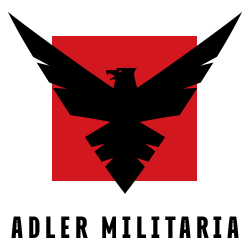Showing 19–27 of 1093 resultsSorted by latest
-
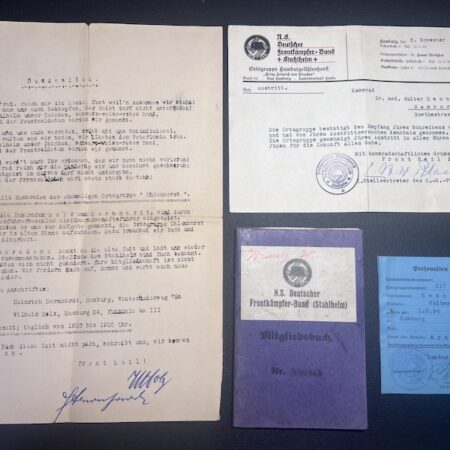
WWII German N.S Stahlhelm Bund Grouping – Dr Hennig -Hamburg – Rare Early ID Set!
Dr Walter Hennig born in 1894 in Hamburg. Served in WW1 as an Oberleutnant from 1914 till 1920! He was awarded the Following Awards: Iron Cross Second Class Iron Cross First Class Schaumburg-Lippe Cross The Hanseatic Cross KuK Military Cross Wounds Badge – Wounded Twice in WW1 He fought in France, Romania, Italy and Russia with the following unit: The Westfälisches Jäger-Bataillon Nr. 7 (7th Westphalian Jäger Battalion) of the Imperial German Army played a significant role in World War I, fighting on both the Eastern and Western Fronts. Initially part of the XX Army Corps, the battalion saw action at the Battle of Tannenberg on the Eastern Front before transferring to Italy and then the Western Front in 1918. The battalion was known for its elite status and experience in mountain warfare, having fought in various theaters including the Vogesen, Alps, and Karpathans. Here’s a more detailed look at the battalion’s involvement in WWI: Formation and Early Service: The battalion was formed in 1815 and saw action in the Franco-Prussian War and other conflicts before WWI. In 1914, it was garrisoned at Ortelsburg (modern Szczytno, Poland) and was part of the XX Army Corps. Eastern Front: The battalion initially served on the Eastern Front, including notable engagements like the Battle of Tannenberg. Shifting Fronts: In 1917, the battalion was transferred to Italy, and in the spring of 1918, it was moved to the Western Front. Elite Status and Training: Jäger battalions were considered elite units within the German Army, known for their training and experience in mountain warfare and raiding tactics. They were often used as assault troops and to revitalize sectors occupied by older troops. Distinctive Features: The 7th Jäger Battalion, like other Jäger units, was typically commanded by younger officers compared to their infantry counterparts. In 1932 he joined the NS Stahlhelm Bund, with Sturm 22 as the Doctor he left the NS Stahlhelm Bund in 1935. The documents are unique, as finding any higher ranks for the Stahlhelm Bund is nearly impossible, the books are usually nearly empty or have no photo. In this case, there is the NS Deutscher Frontkämpfer Bund ID with Uniformed picture.
-
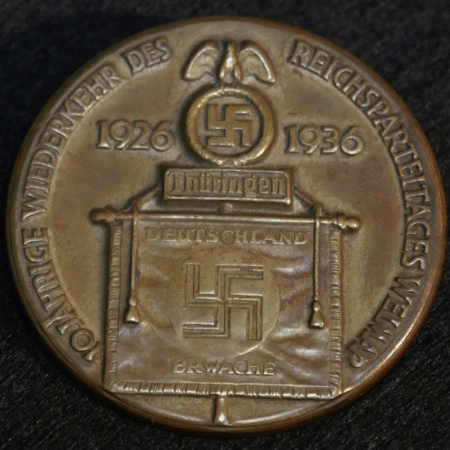
WWII German 10 Year NSDAP Reichsparteitages Weimar 1926-1936 – Deutschland Erwache Standarte – Maker H. WERNSTEIN JENA
Die-stamped metal with a bronze gilt, magnetic, maker marked “H. WERNSTEIN JENA”
-
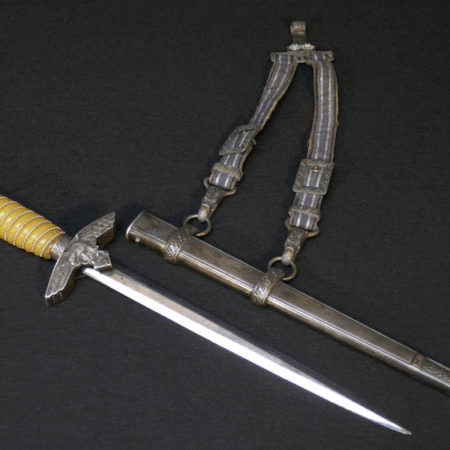
Original WWII German Luftwaffe Officers 2nd Model Dagger made by Ernst Pack & Söhne of Solingen
This is an excellent example of an early Pre-War production 2nd Model Luftwaffe Officer’s dagger, complete with its original scabbard and hangers . It is a fine Solingen-Produced example made by the well known firm Ernst Pack & Söhne of Solingen, please see the photos for condition. Price includes free shipping USA / Europe Tracked.
-
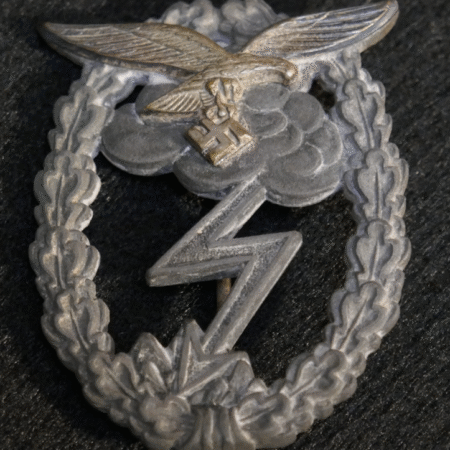
-
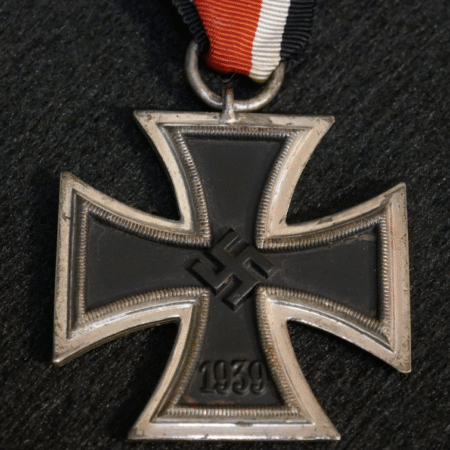
WW2 German Iron Cross Second Class – Mm 106 Gebr Schneider- Wien – Free WW Tracked Shipping!
EK 1939 2 Class, Iron cross 2nd class. 106 Marked, Gebr Schneider- Wien (also known markings BSW on other badges)
-

Original Waffen SS Soldbuch – SS Schützen Heine – SS Polizei Grenadier Regiment 1 – Romanian Volksdeutsche – Riga 1944 – Rare!
Here we have a very interesting SS Soldbuch to Karl Heine, born in 19.7.1925 in Grabatz, Banat Romania. SS Soldbuch Issued with: SS Rekruten Depot der Waffen SS Debicа Below an interesting account from a young soldier in July 1943 in the same place mentioning the many Romanian Recruits. His first frontline unit till late 1943 was: SS Polizei Infanterie Regiment 2 – (Feldpost Number: 32194) The unit was sent towards the Leningrad Front. SS Polizei Grenadier Regiment 1 On January 29, 1943, the remnants of the regiment were withdrawn from the front and transferred to the LIV Army Corps. The division assembled in Sablino. Nominally, the regiment was renamed SS Police Grenadier Regiment 1 on February 1, 1943, but in practice the division’s three SS Police Grenadier regiments were formed into three weak battalions. The division received 1,200 replacements from home on February 9, 1943. At the end of February 1943, the fighting died down. On March 18, 1943, the Red Army launched another offensive, but called it off after two weeks. A comprehensive reorganization of the division and regiment began at the Heidelager training area, followed by its transformation into SS Police Panzergrenadier Regiment 1 on June 6, 1943. The III. Battalion of the SS Police Grenadier Regiment 3 was incorporated as the new III Battalion. On October 22, 1943, the regiment was finally renamed SS Panzergrenadier Regiment 7. It seems that in early 1944, he was sick or wounded, arriving in Riga, Main Hospital Nr 1. (building still standing today!) Interestingly, the unit was not filled out with the new designation although the entries in the Soldbuch go up to April 1944. It seems that he was indeed active again in April of 1944, as he was given pay. Although the unit was involved in killing around 300 Partisans in Greece only a few months later. Also he was issued a full winter compliment! An interesting entry into the equipment page not often seen. Two Security Stamps with SS Officers Signatures worthy of further research. ——————— An Account from July 1943 from another Romanian Volksdeutsche at Debica: In mid-July 1943, Friedrich Bolaritsch from Orschowa/Romanian Banat arrived with approximately 1,000 ethnic Germans after a one-day rail transport to Vienna, where a medical commission examined the volunteers. After two days, all were transferred to the Waffen SS and transported the very next day by rail for three days to Debica. Friedrich Bolaritsch: “At dawn, we marched from Debica train station toward the Heidelager military training area.” We had already loaded our suitcases onto a truck. The paved road led through endless coniferous forest, and heavily armed guards could be seen almost every 500 meters. After walking about three kilometers, we saw the first residential barracks and suddenly found ourselves in the middle of a barrack town. After another two kilometers, we finally reached our destination: a block of empty barracks. Each block, i.e., a certain number of barracks, had a kitchen with a dining room, a bathhouse, a barrack with an infirmary, a canteen, a barrack for cultural events, and a barrack where the brothel (!!!) was located! Several Unterscharfuhrer (Second Sergeants) immediately appeared and greeted us with great cheers. We were assigned to the available quarters, so that every 10 men shared a room with five double beds. We immediately headed to the bathroom, and even before showering, we were carefully examined by some medics for lice or pubic lice; then our haircuts followed. By now it was already midday, and we were almost collapsing from hunger and exhaustion. Our first lunch here in the “Heidela-ger” consisted of meat goulash with boiled potatoes and pudding for dessert…. Immediately after the meal, we had to report to the clothing and equipment reception, which took place in a barracks designated for this purpose. Each of us received: a set A (cloth uniform), a drill suit, a coat, a pair of shoes, three pairs of socks, three pairs of foot wraps, two shirts, three undershirts, a cap/cap; a knapsack (backpack), a haversack, mess kit, eating utensils, a butter dish, a belt, a field flask, a blanket, bed linen, a toiletry bag, a clothes brush, a shoe brush, three handkerchiefs, two uniform collars, a sewing kit with thread, a Shoulder straps, a steel helmet, and a tarpaulin. We carried our things to our barracks, where each was assigned a bed and a locker. Under instruction and constant reminders to hurry, we had to make our beds, organize the lockers, and get dressed. In an incredibly short time, everything was ready, and we suddenly found ourselves as soldiers. We had to pack our civilian clothes in suitcases and label them with our home addresses. They were picked up in the evening… Some tried to lock their lockers with various locks, but shortly afterwards, Uscha appeared, raging and screaming about it. So they were quickly removed! Dawn fell… On that first evening, we were given potato salad with herring, bread, margarine, jam, and cigarettes… At 10 p.m., it was tattoo… Our group consisted of 10 men, all ethnic Germans from Romania and the Batschka (Serbian Banat). Only one was Romanian, his last name was Petru, and he couldn’t speak a word. German… Our day began at 5 a.m. with a wake-up call. The UvD arrived and noticed that our room wasn’t very tidy. We were immediately dragged out of bed and made to report for punishment drills. For the eight or nine days we spent in the “Heidelager,” we endured this every day, with one or two punishment drills per night! After the wake-up call, we had 15 minutes of morning exercise, washed, made the beds, fetched coffee, and cleaned the room. A quarter to seven was “company assembly,” followed by five hours of duty. This consisted exclusively of “geography”…drilling until we dropped…. Every day, we ran about 15 kilometers, threw ourselves to the ground countless times at the command “Full cover,” and jumped at the command “Jump to march!” Jumped up again. Crawling was particularly…
-

WWII Waffen SS Soldbuch Group – SS-Rottenführer Affeldt – SS Panzer Grenadier Regiment 5 “Thule” – Shot in the Face – Captured 1945 – Extremely Rare
Here we have a very interesting SS Soldbuch issued in May 1942 with the Replacement unit (Ersatz) SS Polizei Infanterie Regiment 3 in Holland/Netherlands – s-Hertogenbosch to: Kurt Affeldt (Born 1924 – Died 2012) from Steinhagen, Westfahlen Germany. In his civilian lifer before the war he was a Maschine Engineer/Worker. Units served in: SS Polizei Infanterie Regiment 3 SS Schutzen Regiment 3 The SS Polizei Infanterie Regiment 3 was formed on September 18, 1939, during the formation of the Police Division from militarily trained members of the Order Police. After being assembled and spending three months at the Wandern military training area, the regiment was deployed to the Upper Rhine at the end of February 1940. During the French campaign, the regiment was deployed in June 1940 to storm the Argonne Forest and cross the Ardennes Canal. The fighting for the heights of Rilly and Voncq on June 9 and 10 was particularly fierce. After the fighting ended, the regiment remained in France as an occupation force. Older men were exchanged for younger recruits. From mid-June 1941, the regiment was relocated to East Prussia. On June 30, 1941, the regiment crossed the Lithuanian border and followed the army units northeast. On July 14, it crossed the Daugava River near Dryssa. On the night of July 24, it crossed Ostrow. On August 1, 1941, the regiment moved to capture the key position at Luga. After suffering heavy losses, the regiment ceased its attacks and on August 22, 1941, moved southwest past Sopolje to attack the flank of the Russian positions. To avoid encirclement, the Red Army evacuated the city on September 1, 1941. After breaking through the Russian defenses, the regiment took part in the encirclement of Leningrad and subsequently remained in the Leningrad area. By order of February 10, 1942, the regiment was transferred from the Ordnungspolizei to the Waffen-SS on February 24, 1942, and renamed SS Police Infantry Regiment 3. The regiment remained outside Leningrad for the entire year of 1942 and took part in the heavy defensive fighting there. On January 12, 1943, the Red Army began its winter offensive on the Northern Front. When Russian troops were able to break through the XXVI Army Corps stationed to the south, the SS Police Division with the SS Police Infantry Regiment 1 received orders four days later to fight to free Schlüsselburg and liberate the German troops trapped there. By November 1942 – Affeldt was shot in the face and returned to Germany for treatment. 31a – Infantry Bullet – Left Cheek. He was not released till September 1943, after which he spent some time with a replacement unit in the Netherlands (Nijmegen). By Early 1944, he was assigned to the SS Panzer Division Totenkopf Affeldt spent some time with SS Panzergrenadier Regiment 5 – “Thule” then was assigned in September to the Stab of the Wirtschafts Batl of the SS Panzer Division Totenkopf. 1944: Defensive Battles in the East January–March 1944: Retreat from the Dnieper and the Korsun Pocket Totenkopf was part of Army Group South, fighting in Ukraine. In early 1944, the division was engaged in heavy defensive battles during the Soviet Dnieper–Carpathian Offensive. It helped to relieve and later withdraw from the Korsun–Cherkassy Pocket, avoiding encirclement, though with significant losses. April–July 1944: Poland and the Kovel Sector The division pulled back into Poland, regrouping near Kovel and participating in defensive battles in Galicia. It became part of SS-Obergruppenführer Herbert Gille’s IV SS Panzer Corps, within Heeresgruppe Nordukraine. July–August 1944: Operation Bagration Aftermath The division was ordered northward as part of efforts to stop the massive Soviet Operation Bagration, which devastated Army Group Centre. Totenkopf fought defensive battles near Warsaw and Modlin, facing continuous Soviet offensives. 1944–1945: Battles in Hungary October–December 1944: Operation Panzerfaust and Debrecen Sent to Hungary, Totenkopf took part in Operation Panzerfaust, where the Germans secured control of Hungary following its attempt to exit the war. It fought in the Battle of Debrecen, part of the defense against the Soviet advance into Hungary. December 1944 – February 1945: Battle of Budapest As part of IV SS Panzer Corps, Totenkopf was one of the key divisions involved in relief operations for the encircled German and Hungarian forces in Budapest. Engaged in Operation Konrad I–III, failed attempts to break the siege of the city. Totenkopf suffered extremely heavy casualties in these operations and had to withdraw toward western Hungary. 1945: Final Battles and Surrender March 1945: Operation Frühlingserwachen (Spring Awakening) The division took part in Operation Frühlingserwachen, the last major German offensive of the war, near Lake Balaton in Hungary. Totenkopf was part of 6th SS Panzer Army, tasked with protecting the Hungarian oil fields. The offensive initially made progress but was soon repulsed by the Soviets, leading to a major retreat. April–May 1945: Retreat into Austria The division retreated through Austria, fighting rearguard actions. By April 1945, its remnants were pushed back through Styria, near Graz and Vienna. May 1945: Final Surrender On May 9, 1945, the remnants of the SS Panzer Division Totenkopf surrendered to Soviet forces near Radstadt, Austria, after Germany’s unconditional surrender (May 8). Many surviving members were taken prisoner by the Red Army. Unlike Western Allies, the Soviets dealt harshly with captured Waffen-SS troops, often regarding them as war criminals. A significant number of Totenkopf soldiers were either executed or sent to Gulag camps in the Soviet Union, where many perished. Security Stamps 20.IX.1943 – 8. Genesenden SS Grenadier Ausb u Ers Batl 4 – Stationed in Nijmegen, Netherlands 6.XII.1943 – 8. Genesenden SS Grenadier Ausb u Ers Batl 4 – Stationed in Nijmegen, Netherlands 4.III.1944 – SS Totenkopf Infanterie Regiment 1.Sept.1944 – Wirtschafts Batl – SS Panzer Grenadier Regiment Totenkopf Awards Black Wounds Badge – 28.1.1943 Silver Wounds Badge – 2.12.1943 – Awarded by the Totenkopf Inf Regiment was likely an upgrade due to the nature of his facial wound. War Merit Cross with Swords – Awarded During the Hungary Operation in Feb 1945 Last Comments A fascinating bit of…
-

Heinrich Himmler Signed Visitor Card with Dedication (1940) – Extremely Rare
Heinrich Himmler Signed Business Card with Dedication (1940) Description: Original business card of Heinrich Himmler, Reichsführer SS, with handwritten dedication and signature on reverse. Front : Name: Heinrich Himmler Title: Reichsführer SS Typeface: Fraktur (Gothic script) Inscription (German): „Meine herzlichsten Wünsche zur Hochzeit“ Translation: “Heartfelt Wishes on your Wedding Day !” Date: 25.VII.40 (25 July 1940) Period: Shortly after the German victory over France (May–June 1940) Extremely Rare item, Himmler has signed many documents but this is a first I have seen on his visitor card.
-

WWII German Soldbuch – FJ Egon Steinhagen – Regiment Kratzert – Battle of Berlin 1945 – Rare
Steinhagen was enlisted on the 27th of March 1945 at 17! Assigned to the Fallschrimjäger unit on the 9th of April 1945. Fallschrimjäger Ersatz und Ausbildungs Regiment 1 Also known as Regiment Kratzert named after the Austrian Regimental Commander. Major Rudolf Johann Kratzert – Knights Cross Holder in 1942 renamed Fallschirm-Jäger-Ausbildungs-Regiment 1. Reorganised in 1943 and moved to Bar le Duc in France, now known as the Fallschirm-Jäger-Ausbildungs-Regiment (no number). In 3.44 renamed: Fallschirm-Jäger-Ersatz- und Ausbildungs-Regiment 1. Withdrawn from France after the Allied invasion, and demobilized. Reformed 1.45 in Halberstadt, with I. Battalion at Quedlinburg, subordinated to the Fallschirm-Jäger-Ausbildungs- und Ersatz-Division. On 14.4.45 had 4500 men in the Oder/Berlin area, for the defence of Berlin.
